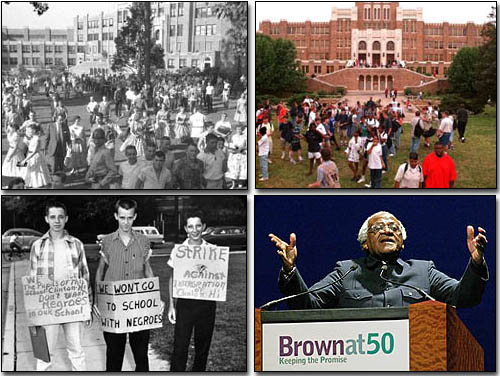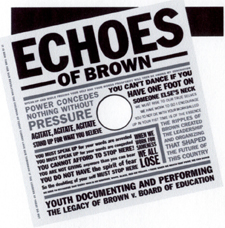
When the U.S. Supreme Court handed down Brown v. Board of Education on May 17, 1954, N.A.A.C.P. lawyer Thurgood Marshall optimistically predicted that eliminating school segregation nationwide would take five years—at most.
Today, exactly 50 years later, our nation’s schools remain nearly as segregated, and as unequal, as when Brown was decided. Seventy percent of black students currently attend schools where racial minorities are a majority. One-third attends schools that are 90 to 100 percent minority enrollment. Looking back at what might be the most important legal decision of the 20th century, many civil rights advocates rightly decry the paucity of gains. For others, however, the 50th anniversary of Brown presents a much-needed opportunity to press anew for school integration—and to rekindle hope.
Meanwhile, university scholars and nonprofit researchers across the country have made the study of race and public education in America a field of passionate inquiry. Their findings about persistent inequalities fill bookshelves and turn heads, even when they don’t produce action.
To reverse that discouraging trend, an unusual coalition of high school-aged students from in and around New York City has undertaken its own investigation of educational inequity. Led by Michelle Fine, a professor at the Graduate Center at the City University of New York (CUNY), and working with a corps of graduate students, these young researchers have conducted surveys, interviews, and focus groups that uncover, often dramatically, how race still colors learning in too many American classrooms.
In intensive research “camps” that provide a home base, students have become experts in civil rights history and social science research. At the first camp in January 2002, the youth researchers and their CUNY Graduate Center colleagues immersed themselves in methods training, designing the surveys, the questions for interviews and focus groups, and the observation strategies they would then take on the road, to students in their own school and others. In subsequent camps, they analyzed and reflected upon the data they’d collected and created public presentations intended to capture attention.
The project’s approximately 100 student and 13 adult participants say they have learned as much from one another as from the 10,000 high school students who have completed their surveys. One of the first lessons the students taught the adult researchers, for instance, was to modify the oft-used phrase “achievement gap” to put the onus for failure where it rightly belonged; “opportunity gap,” the youth argued, pointed more accurately to the schools and the “system,” rather than pupils. From that point on, they referred to their work as the “Opportunity Gap Project.”
From each other, students have learned the harsh realities of discrimination, as well as the power of seeing the world through different eyes. The youth recruited for the project were purposefully diverse: Caucasian, African-American, Latino, Asian, and Afro-Caribbean; wealthy, middle class, and poor; from urban and suburban schools; and enrolled in special education and honors classes. When confronted with statistics about disparities in college-going youth, the students tackled their personal prejudices—that blacks are less capable than whites, for example, or that Asians are intellectually superior. Clearly such discussions and analyses were painful.
Below WKCD offers some of the fruits of this extraordinary project—along with the students’ challenge that we rise, anew, to the promise of Brown v. Board of Education.
 |
Performance Thirteen of the youth researchers combine forces with a New York choreographer, a spoken word artist, and a videographer to create an interactive, 55-minute production called “Echoes of Brown, 50 Years Later” that situates their own lives in the greater narrative of Brown. For an account of the performance’s recent dress rehearsal, click here. |
 |
Poetry To create the poetry and spoken word pieces at the center of Echoes of Brown, students took an intensive writing workshop led by Urban Word NYC (formerly known as Youth Speaks NY). To read a selection of their poems, click here. |
 |
Findings In March 2003, a group of the project’s youth researchers and adult partners presented their initial findings—detailed charts summarizing data mixed with poetry and drawings—to an audience at New York City’s Bank Street College. For an abbreviated version of this 75-slide PowerPoint presentation, click here. |
 |
Interview Through this and other projects, Michelle Fine and Maria Elena Torre of the Graduate Center at CUNY have accumulated a wealth of experience in “participatory action research” with young people. To read a recent WKCD interview with Fine and Torre, click here. |
SEE ALSO:
Resources for teaching about civil rights and about Brown v. Board of Education
Two recent reports on school desegregation
In July 2004, Teachers College Press will distribute a DVD and book that documents the accumulated work of the Opportunity Gap project. The DVD feature is a 54-minute documentary, "Echoes of Brown, 50 Years Later," which explores youth activism through spoken work and dance in response to elder voices and the continuing inequities. Other selections on the DVD include complete elder interviews, student spoken word performances, contemporary educator responses, research statistics and researcher interviews. For more information, click here.
The Opportunity Gap Researchers
From The CUNY Graduate Center, Center for Human Environments:
Michelle Fine, Principal Investigator; María Elena Torre, Project Director; Jennifer Ayala, Janice Bloom, April Burns, Lori Chajet, Monique Guishard, Yasser Arafat Payne, Tiffany Munn-Perkins and Kersha Smith
From Urban and Suburban High Schools and Communities:
-Columbia High School, Maplewood, New Jersey: Esther Akutekha, Yelena Allakhverdev, Fabienne Aubourg, Jacob Bartholemew, Amir Bilal Billups, Emily Brisbon, Melanie Harris, Charles Penn, Kareem Sergent, Desmonae Perry
-East Side Community High School, New York, New York: Nikaury Acosta, Jasmine Castillo, Candice DeJesus, Emily Genao, Monica Jones, Seekqumarie Kellman, Luis Murillo, Amanda Osorio, Noman Rahman, Lisa Sheard, Jeremy Taylor
-Fox Lane High School, Bedford, New York: Nicole Artis, Phil Bryd, Jeanne Clark, Nicole Lopez, Sekina Robinson
-John F. Kennedy High School, Paterson, New Jersey: Tarrick Ahmad, Antoine McKenzie, Shamaya Mickens, Chris Murphy, Reinauris Paulino, Magisel Rivera, Mohammed Romadan, Anthony Smith
-Mothers On the Move, Bronx, New York: Christine Doyle, Jeunesse Jackson, Sati Singleton, Travis Staten, Ashley Webb
-El Puente Academy for Peace and Justice, Brooklyn, New York: Fidel Tavarez, Murillo Tendilla
-Urban Academy, New York, New York: Adam Feeney, Alexis Jones, Joanna Kocub, Vance Rawles
-White Plains High School, White Plains, New York: Jackie Halas, Maria Soto, Peter John Viamonte, Kevin Young
Support for the Opportunity Gap Project has come from the Rockefeller Foundation, Open Society Institute, Leslie Glass Foundation, and the Edwin Gould Foundation.




